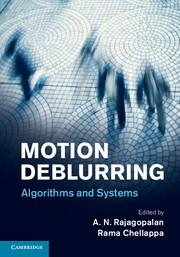Book contents
- Frontmatter
- Contents
- List of contributors
- Preface
- 1 Mathematical models and practical solvers for uniform motion deblurring
- 2 Spatially-varying image deblurring
- 3 Hybrid-imaging for motion deblurring
- 4 Efficient, blind, spatially-variant deblurring for shaken images
- 5 Removing camera shake in smartphones without hardware stabilization
- 6 Multi-sensor fusion for motion deblurring
- 7 Motion deblurring using fluttered shutter
- 8 Richardson–Lucy deblurring for scenes under a projective motion path
- 9 HDR imaging in the presence of motion blur
- 10 Compressive video sensing to tackle motion blur
- 11 Coded exposure motion deblurring for recognition
- 12 Direct recognition of motion-blurred faces
- 13 Performance limits for motion deblurring cameras
- Index
- References
8 - Richardson–Lucy deblurring for scenes under a projective motion path
Published online by Cambridge University Press: 05 June 2014
- Frontmatter
- Contents
- List of contributors
- Preface
- 1 Mathematical models and practical solvers for uniform motion deblurring
- 2 Spatially-varying image deblurring
- 3 Hybrid-imaging for motion deblurring
- 4 Efficient, blind, spatially-variant deblurring for shaken images
- 5 Removing camera shake in smartphones without hardware stabilization
- 6 Multi-sensor fusion for motion deblurring
- 7 Motion deblurring using fluttered shutter
- 8 Richardson–Lucy deblurring for scenes under a projective motion path
- 9 HDR imaging in the presence of motion blur
- 10 Compressive video sensing to tackle motion blur
- 11 Coded exposure motion deblurring for recognition
- 12 Direct recognition of motion-blurred faces
- 13 Performance limits for motion deblurring cameras
- Index
- References
Summary
Introduction
Motion blur from camera egomotion is an artifact in photography caused by the relative motion between the camera and an imaged scene during exposure. Assuming a static and distant scene, and ignoring the effects of defocus and lens aberration, each point in the blurred image can be described as the convolution of the un-blurred image by a point spread function (PSF) that describes the relative motion trajectory at that point's position. The aim of image deblurring is to reverse this convolution process to recover the clear image of the scene from the captured blurry image as shown in Figure 8.1.
A common assumption in existing motion deblurring algorithms is that the motion PSF is spatially invariant. This implies that all pixels are convolved with the same motion blur kernel. However, as discussed by Levin, Weiss, Durand & Freeman (2009) the global PSF assumption is often invalid. In their experiments, images taken with camera shake exhibited notable amounts of rotation that attributed to spatially-varying motion blur within the image. Figure 8.2 shows a photograph that illustrates this effect. As a result, Levin et al. (2009) advocated the need for a better motion blur model as well as image priors to help regularize the solution space when performing deblurring. This chapter addresses the former issue by introducing a new and compact motion blur model that is able to describe spatially-varying motion blur caused by a camera undergoing egomotion.
- Type
- Chapter
- Information
- Motion DeblurringAlgorithms and Systems, pp. 161 - 183Publisher: Cambridge University PressPrint publication year: 2014
References
- 4
- Cited by



